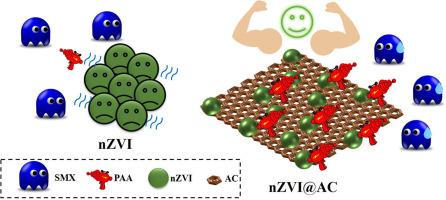活性炭负载的纳米零价铁(nZVI@AC)增强过氧乙酸在fenton样降解磺胺甲恶唑中的活化
IF 5.7
3区 材料科学
Q2 MATERIALS SCIENCE, MULTIDISCIPLINARY
引用次数: 0
摘要
本研究提出了一种新型的纳米零价铁锚定在活性炭(nZVI@AC)催化剂上,旨在克服裸nZVI固有的聚集和氧化限制。nZVI@AC复合材料具有较高的过氧乙酸(PAA)活化催化活性,可在10 min内完全降解磺胺甲恶唑(SMX) (kobs = 0.3171 min-1)。表征证实了交流载体显著增强了电子转移和给电子能力。这最大限度地暴露了活性Fe2+物种,这对于有效激活PAA和活性氧(ROS)的产生至关重要。自由基猝灭、电子顺磁共振和探针实验发现羟基自由基、单线态氧(1O2)和乙酰过氧自由基是主要的ROS,其中1O2起主导作用。nZVI@AC/PAA体系表现出显著的稳定性和实际可行性。这项工作确立了nZVI@AC作为一种高效、稳定和通用的催化剂用于paas基高级氧化过程,具有良好的水修复应用潜力。本文章由计算机程序翻译,如有差异,请以英文原文为准。

Activated carbon-supported nano zero-valent iron (nZVI@AC) for enhanced peracetic acid activation in Fenton-like degradation of sulfamethoxazole
This study presented a novel nano zero-valent iron anchored on activated carbon (nZVI@AC) catalyst, designed to overcome the inherent aggregation and oxidation limitations of bare nZVI. The nZVI@AC composite exhibited high catalytic activity for peracetic acid (PAA) activation, achieving complete degradation of sulfamethoxazole (SMX) within 10 min (kobs = 0.3171 min-1). Characterizations confirmed that the AC support significantly enhanced electron transfer and increased the electron-donating capacity. This maximized exposure of active Fe2+ species, which was crucial for efficient PAA activation and reactive oxygen species (ROS) generation. Radical quenching, electron paramagnetic resonance, and probe experiments identified hydroxyl radicals, singlet oxygen (1O2), and acetylperoxyl radicals as the primary ROS, with 1O2 playing the dominant role. The nZVI@AC/PAA system demonstrated remarkable stability and practical viability. This work established nZVI@AC as an efficient, stable, and versatile catalyst for PAA-based advanced oxidation processes, offering promising potential for water remediation applications.
求助全文
通过发布文献求助,成功后即可免费获取论文全文。
去求助
来源期刊

Materials Research Bulletin
工程技术-材料科学:综合
CiteScore
9.80
自引率
5.60%
发文量
372
审稿时长
42 days
期刊介绍:
Materials Research Bulletin is an international journal reporting high-impact research on processing-structure-property relationships in functional materials and nanomaterials with interesting electronic, magnetic, optical, thermal, mechanical or catalytic properties. Papers purely on thermodynamics or theoretical calculations (e.g., density functional theory) do not fall within the scope of the journal unless they also demonstrate a clear link to physical properties. Topics covered include functional materials (e.g., dielectrics, pyroelectrics, piezoelectrics, ferroelectrics, relaxors, thermoelectrics, etc.); electrochemistry and solid-state ionics (e.g., photovoltaics, batteries, sensors, and fuel cells); nanomaterials, graphene, and nanocomposites; luminescence and photocatalysis; crystal-structure and defect-structure analysis; novel electronics; non-crystalline solids; flexible electronics; protein-material interactions; and polymeric ion-exchange membranes.
 求助内容:
求助内容: 应助结果提醒方式:
应助结果提醒方式:


